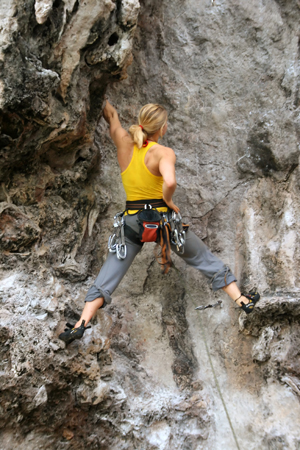Edward Whymper famously said "Climb if you will, but remember that courage and strength are nought without prudence....". He was not referring only to the Matterhorn - any mountain can be a killer if proper care is not taken. The advice that follows cannot be comprehensive and must therefore be regarded as incomplete. Those embarking on potentially hazardous activities should without exception seek and heed appropriate professional and local safety advice.
Climbers should wear helmets and carry ice-axes, especially in winter. Proper climbing or hiking boots are essential for protection, avoiding accidents and keeping the feet dry. In winter conditions, an ice-axe and crampons may be needed. Clothing should be layered and include warm, windproof and waterproof garments. A spare fleece, gloves and a hat should also be carried. Cotton shirts are cold when wet with sweat, but modern wicking thermal vests are useful all year round.
 Leave a record of the planned route, starting and finishing points, and the estimated time of return with a responsible person. Remember to inform this person when the group returns. If plans or events change, let friends and family know. If necessary, inform the police you are safely off the hill or mountain.
Leave a record of the planned route, starting and finishing points, and the estimated time of return with a responsible person. Remember to inform this person when the group returns. If plans or events change, let friends and family know. If necessary, inform the police you are safely off the hill or mountain.
Eat well before setting out on a climb or hike. Cereals and carbohydrates release energy gradually throughout the day. In addition to the usual sandwiches, take high-energy foods such as chocolate, dried fruit, and glucose which restore energy quickly. Warm drinks do wonders for moral. The water in mountain streams is generally drinkable when it runs fast over stony beds.
Essential equipment includes an appropriate map, a compass, a GPS receiver, a mobile phone, a basic first-aid kit, a reliable watch, a whistle, and a torch. Remember that six blasts or flashes repeated at one-minute intervals signal an emergency. A survival bag or modern light-weight emergency shelter can also be invaluable. Mobile phones and GPS receivers are very useful aids but can fail and should not be relied upon entirely.
There is generally safety in numbers but group leaders must have sufficient relevant experience. Those who prefer to climb or hike alone must accept the additional inherent risk. Contingency plans must be discussed and agreed with everyone in a group. Do not allow group members to fall behind behind and catch up later. Take special care of the youngest, weakest and least experienced group members in dangerous places. Don't press on when conditions are against you - turn back even if it upsets group plans. It is no disgrace to turn back even where the decision proves to be over-cautious - a group must be governed by the capabilities of the weakest member. When problems arise, take time to assess the seriousness of the situation and whether the group can help itself. However, call for help as soon as possible once it is clearly needed. Give first aid, and keep injured or exhausted people warm until help arrives.
Aim to be self reliant, and so avoid inconveniencing or endangering others. There is no substitute for experience. Learn to navigate and administer first aid. It is more satisfying to progress gradually towards longer and more difficult routes than to attack the biggest hills before developing the necessary skills.
Dangers which should be avoided by all but the most experienced climbers and hikers include:
- precipices;
- slopes of ice or steep snow;
- very steep grass slopes (particularly when frozen);
- unstable boulders;
- gullies and stream beds;
- streams in spate; and
- snow cornices on ridges or the tops of gullies.
Less obvious, but potentially equally dangerous situations include:
- unexpected changes of weather including mist, high winds, rain or snow - get a forecast and watch the sky;
- ice on the path - know how to use an ice axe and crampons;
- excessive cold or heat - dress sensibly and carry appropriate spare clothing;
- exhaustion - be aware of the signs, rest and keep warm;
- accidents or illness - don't panic, and make sure that any rescuers are given a precise location;
- the flight of time - learn your own pace and that of a group, and plan the route accordingly - allow double the normal time in winter or at night; and
- over-ambitious plans - be realistic, and seek and heed the advice of local experts.